Sea-Level Rise Accelerates in New Jersey, Raising Coastal Flooding Risk, Study Says – Inside Climate News

Report on New Jersey’s Sea-Level Rise and its Implications for Sustainable Development Goals
Executive Summary
A comprehensive report by the New Jersey Climate Change Resource Center at Rutgers University outlines alarming projections for sea-level rise, directly challenging the state’s progress towards several Sustainable Development Goals (SDGs). The findings underscore the urgent need for enhanced climate action (SDG 13) to protect vulnerable coastal areas, ensure the sustainability of communities (SDG 11), and preserve critical ecosystems (SDG 14, SDG 15). The report projects a sea-level rise of 2.2 to 4.5 feet by 2100, contingent on global emissions scenarios, which will severely impact infrastructure, water resources, and public safety.
Analysis of Projections and Alignment with SDG 13: Climate Action
The 155-page document, informed by 144 scientists, provides critical data for addressing SDG 13 by quantifying the local impacts of global climate change. It presents scenarios based on varying levels of global carbon emissions, highlighting the direct link between international climate policy and local outcomes.
Key Projections by 2100
- Intermediate Emissions Scenario: A likely sea-level rise of 2.2 to 3.8 feet. This scenario corresponds to a global temperature increase of approximately 2.7°C.
- Accelerated Ice-Sheet Melt Scenario: A potential sea-level rise of up to 4.5 feet, incorporating the less understood effects of ice loss in Greenland and Antarctica.
Accelerated Rate of Change
The report notes that the rate of sea-level rise is accelerating, posing an increasing threat.
- From 1912 to 2021, the sea level at Atlantic City rose 1.5 feet, a rate of 1.7 inches per decade.
- Between 2040 and 2060, the rate is projected to increase to 2.9 to 4.7 inches per decade.
- Between 2080 and 2100, the rate could reach as high as 5.6 inches per decade.
These projections serve as a stark warning, emphasizing that failure to meet global targets under SDG 13 will have severe, localized consequences for New Jersey.
Impacts on SDG 11: Sustainable Cities and Communities
New Jersey’s densely populated and low-lying coastal areas are exceptionally vulnerable, making the achievement of SDG 11 a significant challenge. The report details how rising seas will undermine the safety, resilience, and sustainability of human settlements.
Increased Flood Hazards
- Flood Day Frequency: In Atlantic City, the average number of “flood days” has risen from less than one per year in the 1950s to 12 per year between 2007-2024.
- Future Projections: By 2050, the city is projected to experience between 29 and 148 flood days annually.
- Compound Flooding: The report warns of the increasing frequency of compound events, where high tides, storm surge, and heavy rainfall combine to exacerbate flooding, threatening critical infrastructure and housing.
The devastation caused by Hurricane Sandy in 2012 serves as a benchmark for the state’s vulnerability. The report’s findings call for urgent integration of climate projections into urban planning and infrastructure development to build resilience in line with SDG 9 (Industry, Innovation, and Infrastructure) and SDG 11.
Threats to Environmental Goals: SDG 6, SDG 14, and SDG 15
The environmental consequences of sea-level rise threaten water resources, marine ecosystems, and terrestrial life, directly impacting several SDGs.
Ecosystem and Resource Degradation
- SDG 14 (Life Below Water) & SDG 15 (Life on Land): Coastal wetlands, which serve as critical habitats and natural buffers against storms, may be unable to adapt to the projected rate of sea-level rise. This could lead to significant biodiversity loss and increased coastal erosion.
- SDG 6 (Clean Water and Sanitation): The report highlights the increasing risk of saltwater intrusion into groundwater aquifers and surface water. This salination threatens the supply of fresh water for drinking and irrigation, particularly on barrier islands, jeopardizing water security for coastal communities.
These environmental impacts demonstrate that climate change is a cross-cutting issue, where failure in one area, such as SDG 13, creates cascading failures across the 2030 Agenda for Sustainable Development.
Conclusion: A Call for Data-Driven Resilience Planning
While the report refrains from making specific policy recommendations, it strongly urges decision-makers to utilize its projections to inform long-term resilience planning and risk assessment. It recommends a review of the scientific estimates at least every five years to adapt to the latest climate science. This approach aligns with the principles of sustainable development, which call for evidence-based policies to protect communities and ecosystems from escalating climate risks. The report serves as a critical tool for policymakers in New Jersey to advance a resilient and sustainable future in the face of climate change, addressing the interconnected challenges encapsulated by the SDGs.
Analysis of Sustainable Development Goals in the Article
1. Which SDGs are addressed or connected to the issues highlighted in the article?
The article on sea-level rise in New Jersey addresses several interconnected Sustainable Development Goals (SDGs). The analysis identifies the following primary SDGs:
- SDG 13: Climate Action: This is the central theme of the article. The entire text discusses the causes (global carbon emissions) and consequences (accelerating sea-level rise, increased flooding) of climate change, directly aligning with the goal of taking urgent action to combat climate change and its impacts.
- SDG 11: Sustainable Cities and Communities: The article heavily focuses on the impact of sea-level rise on coastal communities, specifically mentioning Atlantic City. It highlights the vulnerability of homes, infrastructure, and the increasing frequency of “flood days,” which directly threatens the safety and sustainability of these human settlements.
- SDG 14: Life Below Water: The article discusses the adverse effects of rising seas on coastal ecosystems. It explicitly warns that coastal wetlands, which are crucial for protecting coastlines and wildlife, may be overwhelmed and unable to adapt. This connects directly to the goal of conserving and sustainably using marine resources.
- SDG 6: Clean Water and Sanitation: The report mentions that sea-level rise will lead to the “increasing salination of groundwater for drinking and surface water for irrigation.” This issue of saltwater intrusion into freshwater sources is a direct threat to water quality and availability, which is the core focus of SDG 6.
2. What specific targets under those SDGs can be identified based on the article’s content?
Based on the issues discussed, several specific SDG targets can be identified:
- Under SDG 13 (Climate Action):
- Target 13.1: “Strengthen resilience and adaptive capacity to climate-related hazards and natural disasters in all countries.” The article’s detailed forecasts of sea-level rise, flood frequency, and storm impacts are intended to inform policymakers and communities to build resilience against these specific climate-related hazards. The devastation caused by Hurricane Sandy is cited as a benchmark for the state’s vulnerability, underscoring the need for improved adaptive capacity.
- Under SDG 11 (Sustainable Cities and Communities):
- Target 11.5: “By 2030, significantly reduce the number of deaths and the number of people affected and substantially decrease the direct economic losses… caused by disasters, including water-related disasters…” The article’s focus on the “rapidly increasing” flood hazards along the coast and the potential for “compound flooding” directly relates to mitigating the impact of water-related disasters on densely populated areas.
- Target 11.b: “…implementing integrated policies and plans towards… adaptation to climate change, resilience to disasters…” The article mentions that the report was commissioned by the state’s Department of Environmental Protection and urges policymakers to review the scientific estimates to inform their “long-term resilience goals,” which aligns with this target of integrating climate adaptation into planning.
- Under SDG 14 (Life Below Water):
- Target 14.2: “…sustainably manage and protect marine and coastal ecosystems to avoid significant adverse impacts, including by strengthening their resilience…” The article warns that “future projected rates of sea-level rise in New Jersey may exceed the pace at which many coastal wetlands are able to adapt,” highlighting a direct threat to these vital coastal ecosystems and the need for action to protect them.
- Under SDG 6 (Clean Water and Sanitation):
- Target 6.3: “By 2030, improve water quality by reducing pollution…” While not about pollution in the traditional sense, the article’s warning about the “increasing salination of groundwater for drinking and surface water for irrigation” points to a degradation of water quality caused by saltwater intrusion, a key concern for this target.
3. Are there any indicators mentioned or implied in the article that can be used to measure progress towards the identified targets?
Yes, the article provides several specific quantitative and qualitative indicators that can be used to measure the problems and track progress towards the identified targets.
- Indicator for Sea-Level Rise (Targets 13.1, 11.5): The article provides precise measurements and projections for sea-level rise.
- Measurement: “seas at Atlantic City rose about 1.5 feet from 1912 to 2021.”
- Projection: “between 2.2 and 3.8 feet of sea-level rise by 2100” under an intermediate emissions scenario.
- Rate of Change: “an average rate of 1.7 inches a decade” historically, projected to rise to “2.9 to 4.7 inches of sea-level rise a decade between 2040 and 2060.”
- Indicator for Flood Frequency (Targets 13.1, 11.5): The number of coastal flood days is used as a direct measure of community vulnerability.
- Historical Data: “Atlantic City, which saw an average of less than one such day a year in the 1950s; 12 a year between 2007 and 2024, and an all-time high of 23 in 2024 alone.”
- Future Projections: “By 2050, the city will likely see between 29 and 148 flood days a year.”
- Indicator for Ecosystem Health (Target 14.2): The article implies an indicator related to the resilience of coastal wetlands.
- Qualitative Indicator: The ability of coastal wetlands to “build up sediment to protect themselves from rising seas.” The report warns that they may be at a tipping point where the rate of sea-level rise exceeds their adaptive capacity.
- Indicator for Water Quality (Target 6.3): The article implies an indicator related to water salinization.
- Qualitative Indicator: The extent of “saltwater intrusion” into groundwater aquifers and surface water used for drinking and irrigation, particularly on New Jersey’s barrier islands.
4. Summary Table of SDGs, Targets, and Indicators
| SDGs | Targets | Indicators Identified in the Article |
|---|---|---|
| SDG 13: Climate Action | 13.1: Strengthen resilience and adaptive capacity to climate-related hazards and natural disasters. |
|
| SDG 11: Sustainable Cities and Communities | 11.5: Significantly reduce the number of people affected and economic losses from disasters, including water-related disasters. |
|
| SDG 14: Life Below Water | 14.2: Sustainably manage and protect marine and coastal ecosystems to avoid significant adverse impacts. |
|
| SDG 6: Clean Water and Sanitation | 6.3: Improve water quality. |
|
Source: insideclimatenews.org
What is Your Reaction?
 Like
0
Like
0
 Dislike
0
Dislike
0
 Love
0
Love
0
 Funny
0
Funny
0
 Angry
0
Angry
0
 Sad
0
Sad
0
 Wow
0
Wow
0
















































:focal(1500,1000)/https://media.globalcitizen.org/a6/9a/a69a4720-d8a1-4715-b596-18738d03c05c/rotary_polio_hero_image.jpg?#)







/countries/sri-lanka/photo-credit---dmc-sri-lanka.tmb-1200v.jpg?sfvrsn=dc298bcc_1#)

















